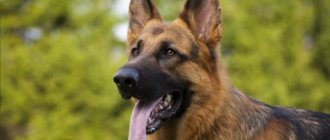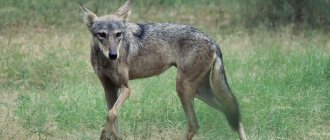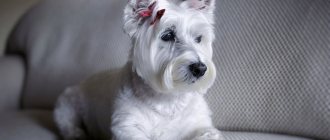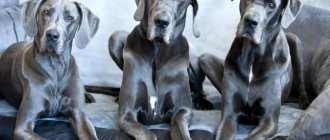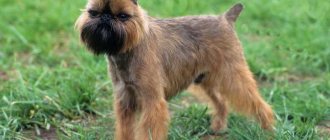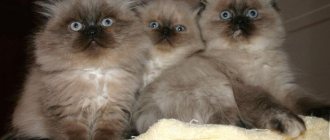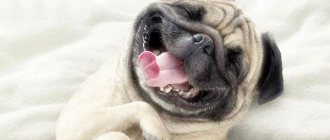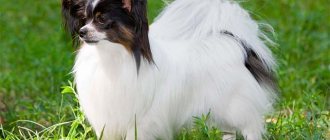In Germany, three types of universal hunting breeds were bred with one main difference - long hair. Langhaar has long hair, Drathaar has half-long hair, and Kurzhaar has short hair. However, Langhaar was and remains little known and most often not even mentioned in the context of German cops. The appearance of the breed is also not very helpful; the Longhaired German Pointer is very similar to the Setter, common features are noticeable even in the photo.
Origin story
Information about long-haired hunting dogs has been found in Germany since the Middle Ages. Initially, they were used to search for and drive game into nets. The ancestors of modern Langhaars were probably quail dogs and French epagnoles. Since 1879, Langhaar has been bred in its pure form. The breed is closely related to the Greater Münsterlander. Initially, it would have been only a color variation of the longhaired pointer, but completely separated from it at the beginning of the twentieth century.
The main organization that controls the breeding of the German Langhaar (German: Deutsch Langhaar) is the German Langhaar Association (DLA), founded in 1926. Today DLA unites 13 breed clubs and breeders around the world.
Purpose
The hunting qualities of the langhaar are fine-tuned at the genetic level. These dogs have a calm, focused search, making them suitable for controlled hunts. Without any hesitation, the Langhaar will climb after a duck through the reeds, even into cold water. A dense undercoat and a sufficient level of sebum will protect the skin from getting wet and hypothermia. A keen sense of smell and a solid stance make him suitable for working in the field. Langhaar easily navigates wooded areas and is not afraid to go through dense thickets. Drives game with a voice. They hunt with it various species of birds, small animals and large ungulates.
The Langhaar is not suitable for hunters who need a dog with clear specialization and quick search.
Training
Dogs of this breed are trained very quickly and carry out every command with great desire. But in time for training. You should not forget about a tasty reward for a well-executed command, then the process will go even faster and at the same time the pet will establish a connection with the owner. Langhaars are active dogs and therefore need regular walks.
Important: Dogs of this breed do not like to walk with a leash, so it is better to go outside the city for walks.
Appearance
The German Longhaired Langhaar is a strong, muscular, medium-sized dog with a proportional, harmoniously built body and dense hair that is elongated on the ears, back of the limbs and tail. Sexual dimorphism is moderately expressed.
- Height at withers of females 58-66 cm; weight - about 27 kg;
- Height at the withers of males - 60-70 cm; Weight - about 30 kg.
Particular attention is paid to the beauty of the head. It should be elegant and elongated. The muzzle and skull are the same length. The skull is slightly convex. The stop is pronounced, but not sharply. The muzzle is long, not too narrow. The lobe is brown. The dental formula is complete. Scissor bite. The eyes are as dark as possible. The ears hang down along the cheekbones, are well covered with long wavy hair, and are not set too high. The neck is noble, strong, widening towards the chest.
The body is balanced, strong, with developed muscles. The back is strong, straight, not very long. The loin is very muscular. The croup is moderately sloping and long. The chest is wide, deep, reaching to the elbows. The forelimbs, when viewed from the front, are vertical. Paws are strong, well assembled, strong.
The skin fits tightly throughout the body and does not form wrinkles. The coat is wavy in places, but should not be curly. The length of the spine is 3-5 cm along the body. On the ears, back of the limbs, tail - longer, and short on the muzzle and front of the limbs. The texture is quite rough. The undercoat is dense and does not stand out from under the top coat. Three colors are allowed:
- Brown;
- White-brown;
- Brown roan.
How to choose a healthy puppy
By the age of 2 months, puppies are ready to leave their mother and move to a new home with new owners.
By this period, their physical and mental development reaches a level where separation from the female is absolutely painless.
When choosing a pet, pay attention to the following points:
- The baby’s behavior will demonstrate the main character traits. If the puppy behaves actively, playfully, and makes contact, most likely, this is a future leader. An independent animal will show indifference soon after meeting, and a modest and insecure puppy will hide in the corner. Also observe how the puppies interact with each other, who leads and who obeys.
- Ask about the parents' hunting history if you plan to use the dog as a working companion.
- Assess your place of residence and conditions.
- It is equally important to choose a healthy baby, so examine the dog’s ears, eyes, teeth, mouth, and coat.
Important! To better understand the character of the animal, do a test: lay the puppy on its back and lightly hold it with your palm on the sternum. If the baby actively breaks free and tries to bite you: in front of you, most likely, is the future leader. If the puppy flounders, squirms, tries to escape, but eventually calms down, this indicates a strong and rather stubborn character. But weak-willed kids will not make any attempts to free themselves; on the contrary, if you show strength, he will try to find contact.
The price of puppies depends on many factors (purity of the breed, availability of certificates from parents, purchases from professionals) and averages $600-800.
Character and behavior
Langhaar is balanced, calm and reserved, with a gentle disposition. Smart and quick-witted, he is very attached to family members. Around his family he is gentle and friendly. May experience anxiety if left alone for a long time. Guard qualities are usually weakly expressed, aggression is completely stopped. The Langhaar gets along well with other dogs of different breeds. With cats and other animals that I grew up with. Small animals and birds on the street may be perceived as potential prey.
Attachment to the family, friendly disposition and high level of obedience make the Langhara a wonderful companion for active people.
It is worth considering that the German pointer has a pronounced hunting instinct and passion for pursuit. The dog must work. If for some reason she leads a “sedentary” lifestyle, for example, in the off-season, she needs to be provided with alternative activities. Various sports are well suited: agility, obedience, trekking.
What to feed your pet
For such an active and large breed, keeping it in an apartment is strictly not recommended. If the dog lives in the city, the conditions of a private home are most suitable, but keep in mind that even in this case, the need for daily walks and active pastime remains.
He feels most comfortable, free and natural in the countryside, in the village, in a word, closer to nature.
In addition, thanks to its thick, warm coat, the dog is not afraid of cold temperatures, which means it can live in an enclosure.
How to equip an outdoor house for a pet:
- dimensions should be 2x3 m;
- the most successful design: metal frame and wooden cladding;
- if the floor is concrete, be sure to provide wooden flooring, otherwise the dog can get many diseases from hypothermia;
- towards the front wall there should be a slight slope for water;
- Inside it is necessary to place a booth according to the size of the dog, in which the animal will sleep, rest, and shelter from the cold. If winters are particularly harsh in your region, purchase a booth with double walls with an insulating layer between them;
- the door must be equipped with reliable bolts, both inside and outside.
We suggest you read: Esophagitis in cats: causes, symptoms and treatment
When keeping a dog on the street, it is highly not recommended to put a dog on a chain, because it irritates the animal, causes psychological and physical discomfort, and can provoke negative emotions towards a person.
To raise a Langhaar to be a devoted and loving friend, you need trust, which is difficult to achieve with a chain.
Did you know? A litter of 5-6 puppies is common, but there are record-breaking dogs that make it into the pages of the Guinness Book of Records due to their fertility. So, in 2004, Tia, a female Neapolitan mastiff, gave birth to 24 tiny puppies, of which 4 babies did not survive. The remaining 20 babies were healthy and strong. The litter consisted of 15 boys and 9 girls. Most of the puppies were listed for $1,800 each.
Like any purebred dog, Langhaar can be fed either prepared food or natural food.
If you choose the first option, then do not save money and buy only the highest quality food - super-premium class or holistic.
With the second option, try to base your diet on three components: natural meat (up to 50%), cereals (up to 40%), vegetables and herbs (up to 30%).
If your pet spends a lot of time hunting, it is more convenient to use dry food: they already contain all the substances the pet needs, do not require cooking, and are easy to store and transport.
Important! With natural feeding, it can be difficult to balance the diet and select foods so that the dog receives all the necessary nutrients. Therefore, if your pet eats natural food, it is advisable to give it additional vitamin complexes.
Content Features
Langhaar adapts well to various living conditions. He can live outside all year round in a spacious enclosure with a well-insulated booth or in a private house. The ideal option for him is to live in the countryside in a house with an owner who regularly goes hunting. He can live in the city and even in an apartment, but in this case he will have to pay special attention to socialization and walking.
The German Langhaar is a very hardy, athletic dog that needs good physical exercise. Much more than the average owner can give. He needs daily long walks and the opportunity to run around in open space. In the warm season, he will happily swim and fetch from the water.
Care
German Langhaars do not require complex care. It is enough to periodically brush and bathe the dog as needed, monitor the condition of the ears and claws and teach him to regularly brush his teeth. The ears are the weak point of these dogs and are prone to infections, but regular cleaning and keeping the ear pinna dry after bathing will avoid problems. After walks in nature, ostyaks, burrs, small twigs, etc. can get tangled in the wool.
Care and nutrition
Due to the fact that the German Pointer breed was bred as a universal hunting breed, there are no special requirements for its maintenance. The dog tolerates cool weather well and can live in an enclosure all year round if you equip it with a heated kennel and a canopy with shade in the summer. Regular exercise will allow you to use up the dog’s energy; it will be ideal if you still get a dog for hunting. Living in an apartment is contraindicated for the breed; excess energy will spill over into the destruction of interior items and damage to things.
A strong immune system protects your dog from diseases and can be maintained through timely vaccination. Paw pads, ears, teeth and eyes require a preventive examination; this can be done once a week.
Beautiful coat also does not require special care; it is enough to comb it regularly, avoiding the accumulation of dead undercoat. An undeniable advantage of the Langhaar's wool structure is its inability to form tangles. You are allowed to bathe cops once a month, using special dog shampoos if necessary.
The breed has no hereditary diseases; only the ears require special monitoring, but if you regularly examine them and wipe them with cotton swabs, this is often enough.
The Langhaar breed is unpretentious in nutrition; it is suitable for both natural nutrition and premium-class dry food. If you choose natural food for your dog, the basis should be lean meat, boneless fish, vegetables and fruits. You can give boiled offal, porridge with vegetable oil. But despite the unpretentiousness of the breed, table scraps, sweets and bread should not be given as food. In the off-season, it is advisable to add vitamin-mineral complexes; their need should be checked with your veterinarian.
Where to buy a German Langhaar puppy
The German Langhaar has long been actively bred in Austria and the Czech Republic. The level of dogs and kennels here almost reaches the German level. The breed is quite popular in Italy, Switzerland, France, and Scandinavian countries. There are breeders in the United States. In Germany the breed is very loved and popular. On average, about 650 puppies are registered per year. It is very strange that the German Langhaar has not taken root in Russia, unlike its closest relatives: the Shorthaired Pointer and the Drathaar. Representatives of the breed in the vastness of the post-Soviet space can almost be counted on one hand.
Price
The price of a German Langhaar puppy in Germany usually ranges from 500-1000 euros. It is better to buy a dog through a breed club, but it is worth considering that at DLA puppies are sold only to hunters.
general characteristics
Nobility, gentleness and intelligence - this combination turns the Langhaar dog into a very pleasant pet and valuable companion. He can guard the household, help look after children, keep a lonely person company and, of course, is simply invaluable on the hunt. Plus, he is quite suspicious of strangers, which reduces the likelihood of this rare dog being stolen.
Yes, Langhaar puppies are quite a rarity today, which also affects their price. But if you find a kennel or dog handler who knows where to get this handsome dog, then the problem will be solved. And the breed is worth such efforts, because its advantages are not limited to spiritual qualities and intelligence. Outwardly, she is also very beautiful and elegant, like all the best representatives of the cops.
Brief historical background
The closest relatives of the langhaars are the drathaars (wire-haired pointers) and the shorthaired pointers (short-haired pointers) . These breeds have a common origin and were obtained on the basis of one original stock, but as a result of selection, each of them acquired its own individual characteristics. It is believed that ancient water spaniels (French Espanolas) and German quail (bird) dogs took part in the formation of these cops.
Selection work began back in the 90s of the 18th century; in 1879, the first breed standard was described and the breeding of pure breed lines of Langhaar began. However, these animals were too heavy and powerful, slow in work and a little clumsy. To lighten the breed and eliminate these shortcomings, the blood of setters (Irish and Gordon) was infused. After stable individuals were obtained (in 1954), the standard characteristics underwent some changes, and the Langhaar was recognized by the International Canine Association.
In ancient photographs you can see dogs that look like Langhaars
The latest current and valid standard dates back to March 16, 2001. In the FCI register, the Langhaar is included in group 7 - pointers (section 1 - continental pointers) under number 117.
